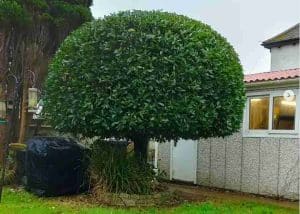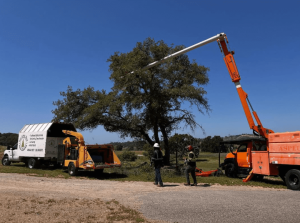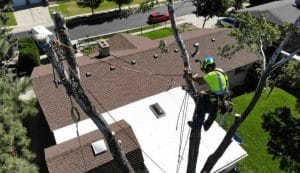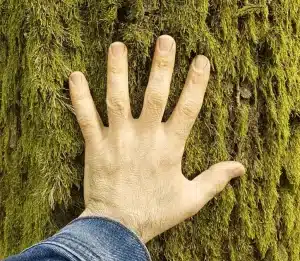Keep your trees healthy year-round with this season-by-season approach tailored for Florida’s unique climate.
Florida’s tree care needs don’t follow the same rules as other parts of the country. Here in Volusia County, we deal with heat, heavy rain, hurricanes, and long growing seasons. That means tree problems show up at different times, and missing a season can cost you more than just looks. It can lead to storm damage, pests, or even tree loss. One method we often rely on is late-winter pruning, especially for shaping and preparing for hurricane season before growth surges. But that’s just one piece of the puzzle. Each season comes with its own must-do tasks to keep your trees strong and safe. In this guide, we’ll walk you through exactly what to do each season—so your trees not only survive, but thrive.
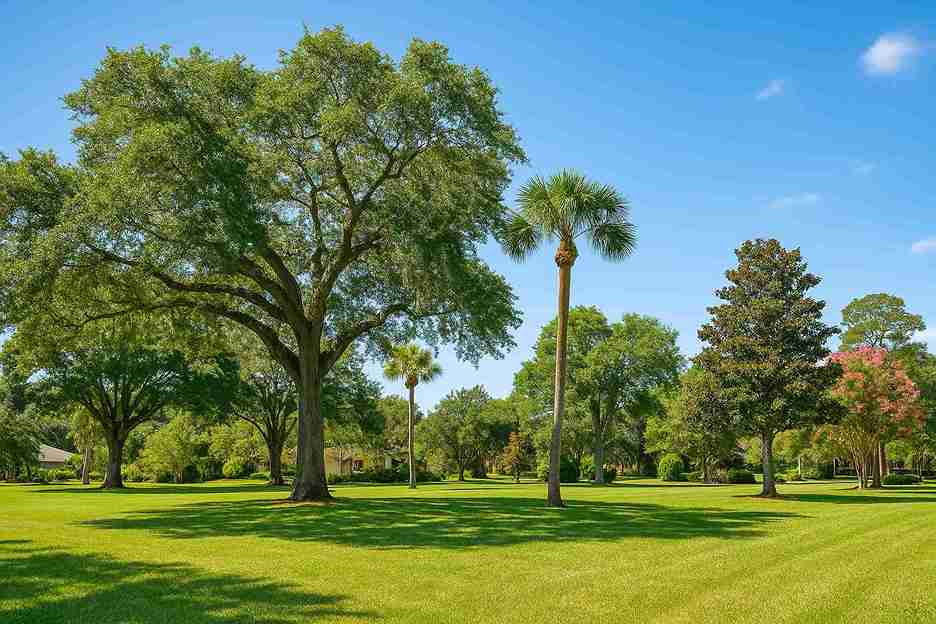
Table of Contents
Why Seasonal Tree Care Matters in Florida
Caring for trees in Florida isn’t as simple as watering now and then. In Volusia County, trees face intense summer storms, prolonged droughts, and soil that doesn’t always give roots what they need. Trees here don’t go fully dormant in winter either, so timing matters more than you might expect.
Here’s why staying on top of seasonal tree care matters:
- Hurricane protection: Weak limbs and unstable roots are more likely to break during storms.
- Pest prevention: Insects and fungi love Florida’s humidity and warmth—they show up earlier and stick around longer.
- Stronger growth: Doing the right thing at the right time leads to better root systems and thicker canopies.
- Avoiding costly removal: Spotting problems early reduces the risk of losing mature trees or needing emergency services.
- Boosting curb appeal and property value: Healthy trees make your yard look better and increase home value.
Let’s break it down season by season.
Winter (December to February): Prune, Plan, and Prepare
Winter in Florida isn’t about snow—it’s about opportunity. This is when most trees slow down just enough for safe trimming, cleanup, and planning ahead.
What to Focus On:
1. Prune dormant trees
This is the safest time to cut branches because trees aren’t actively growing. You can see the full structure without leaves blocking your view. Trim dead, diseased, or poorly placed branches now to avoid issues during hurricane season.
2. Remove risky or declining trees
Winter is the best time to remove trees that are already leaning, split, or hollowing out. Doing this now avoids the stress and danger of removing them during storm season.
3. Inspect tree trunks and roots
Walk your property and look for signs of cracking, leaning, rot, or insects. A little effort here can prevent major issues later.
4. Clear fallen leaves and debris
Leaf litter can smother roots and hide pest problems. Clean up around tree bases to keep air and sunlight reaching the soil.
Winter Tip:
Schedule a tree health check during the off-season. This is when tree experts have more availability and may offer lower rates.
Spring (March to May): Feed, Mulch, and Watch for Bugs
Spring wakes your trees up. This is when growth picks up fast, and pests start showing up. Support this stage with nutrition and good habits.
What to Focus On:
1. Apply slow-release fertilizer
Use a fertilizer designed for Florida trees, and spread it around the “drip line” (where the outer branches end). Avoid placing it near the trunk.
2. Mulch to protect roots
Mulch helps hold moisture, block weeds, and regulate soil temperature. Add 2–3 inches around the base but keep it away from the trunk to avoid rot.
You may try: palm tree trimming ormond beach
3. Begin pest prevention
Early spring is when pests like aphids, whiteflies, and caterpillars emerge. Spot-treat with horticultural oil or insecticidal soap before infestations get bad.
4. Water young trees
New or small trees need regular deep watering, especially as temperatures rise. Water once or twice a week with enough volume to soak the roots.
5. Watch for early signs of disease
Spring warmth and rain can lead to fungal issues. Look for spots on leaves, white patches on bark, or mushrooms near the roots.
Spring Tip:
If you notice mushrooms or a white powder around the base of a tree, it may be root rot. Treat it early—waiting could cost you the whole tree.
Summer (June to August): Protect Against Storms and Heat
Summer is Florida’s most dangerous season for trees. Between high winds, lightning, heat stress, and flooding, your goal should be to protect and monitor—not prune.
What to Focus On:
1. Avoid major trimming
Heavy pruning in summer weakens trees. Only cut limbs if they’re threatening your home, power lines, or walkways.
2. Inspect after storms
Look for broken limbs, cracks, exposed roots, or lightning scars. Acting quickly after storms reduces long-term damage.
3. Deep water during dry spells
It rains a lot—but it also dries out fast. Water slowly and deeply when rain has been absent for more than a few days.
4. Watch for hurricane hazards
Trees with weak branches, crossing limbs, or multiple trunks may need bracing or cabling. Fixing this early can save the tree.
5. Look for heat stress
Signs include curled leaves, browning tips, or leaves dropping too early. If you see this, improve watering and check soil conditions.
Summer Tip:
Build a tree storm-prep checklist now. Know which trees need trimming, who to call for urgent help, and where your yard is most at risk.
Fall (September to November): Build Strong Roots and Prep for Cool Weather
Florida’s fall still feels warm, but trees are starting to slow down. Use this season to strengthen roots, refresh the soil, and plant new trees for the best start.
What to Focus On:
1. Stimulate root growth
Add organic root stimulators with mycorrhizae or compost tea to help roots go deeper and get stronger before winter.
2. Loosen compacted soil
If the ground is hard and dry, aerate around the base of trees to help air, water, and nutrients reach the roots.
3. Treat pests before winter
Spider mites, scale insects, and whiteflies are common in fall. Treat now to avoid overwintering populations.
4. Plant new trees
Cooler weather with moist soil creates the best conditions for establishing new palms, oaks, or flowering trees.
5. Clean up leaf litter
Rotting leaves attract pests and spread fungi. Rake and remove fallen debris regularly, especially near tree trunks.
Fall Tip:
Stop fertilizing trees after early November. Late feeding encourages new growth that can get damaged if a cold snap hits.
Common Tree Problems in Volusia County (And How to Fix Them)
Some issues are specific to this region and its weather. Here are local problems and what to do:
| Problem | What to Look For | What to Do |
| Root Rot | Mushy base, sour smell, yellow leaves | Improve drainage, avoid overwatering |
| Aphids | Sticky leaves, tiny bugs under leaves | Spray with soapy water or neem oil |
| Lightning Damage | Burn marks, bark splitting | Prune damaged areas and monitor for dieback |
| Leaning Tree | Tilted trunk, loose soil at base | Stake young trees; call an arborist for older ones |
| Sooty Mold | Black film on leaves | Control insects like scale or aphids causing it |
Seasonal Tips for Popular Florida Trees
Certain trees need extra attention depending on the time of year.
Live Oak
- Prune in winter to shape and prevent overgrowth.
- Mulch and water in spring to support root health.
- Check for girdling roots in fall.
Sabal Palm
- Remove only fully dead fronds year-round.
- Feed with palm fertilizer in spring and early fall.
- Avoid “hurricane cuts”—they weaken the tree.
Magnolia
- Trim lightly in late winter for shape.
- Clean up fallen leaves in fall to avoid pests.
- Check for white scale insects in spring.
Crape Myrtle
- Prune in late winter but never top them.
- Water in dry months to protect new growth.
- Feed in spring to encourage healthy blooms.
Final Thoughts: A Little Each Season Goes a Long Way
Healthy trees aren’t a one-time job—they grow, change, and face new risks every season. When you follow a seasonal care plan, you keep your trees in shape and avoid big surprises down the road. Whether you’re trying to boost curb appeal, make shade for your yard, or avoid storm cleanup, each small seasonal task adds up to big long-term results.
Start with the season you’re in right now. Use this calendar as your guide. With just a little work each month, your trees will be stronger, safer, and more beautiful all year long.

FAQs
Best time to trim trees in Volusia County?
Trim trees in winter, between December and February, while they’re dormant. It’s the safest time and helps reduce storm damage later.
Do I need a permit to cut trees in Volusia County FL?
Yes, most cities in Volusia County require a tree removal permit. Check local rules before cutting to avoid fines or delays.
How do I prepare trees for hurricane season FL?
Cut dead branches, trim overhangs, and check for weak limbs by early summer. Healthy trees can better survive Florida storms.
When should I fertilize my trees in Florida?
Fertilize trees in early spring and again in late summer. Use slow-release fertilizer to support healthy root growth.
What tree pests are common in Volusia County?
Watch for aphids, caterpillars, whiteflies, and scale. These pests thrive in Florida’s warm climate and can damage trees fast.
Can I plant new trees in summer in Florida?
It’s possible, but fall is best. Cooler weather and steady rain help roots grow strong before summer heat returns.
How often should I water trees in Central Florida?
New trees need deep watering twice a week. Mature trees need less, but still check soil moisture in dry months.
Why should I mulch around my Florida trees?
Mulch keeps soil moist, blocks weeds, and protects roots. Keep it 2–3 inches thick and away from the trunk to prevent rot.
What trees grow best in Volusia County FL?
Native trees like live oak, sabal palm, and magnolia handle Florida heat, pests, and storms better than non-native trees.
How do I know if a tree is sick or dying?
Signs include leaf drop, cracked bark, fungus at the base, or a leaning trunk. Call a tree expert if you spot these signs.
